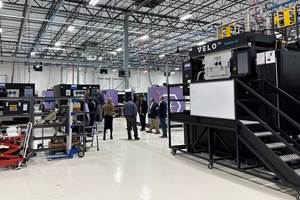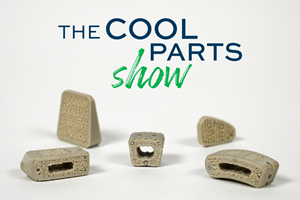SLM Titanium Expands Options for Hearing Aid Wearers
Titanium plus selective laser melting (SLM) enables hearing aids that perform better for a wider range of individuals.
"Invisible in canal" (IIC) hearing aids are a popular choice for individuals with hearing loss. More discreet than in the ear (ITE) or behind the ear (BTE) designs, IIC devices are hidden completely (or nearly so) inside the ear canal. Because they are placed so close to the ear drum, IIC devices reduce ambient noise and improve sound quality for wearers.
But IIC hearing aids also come with some critical tradeoffs. Because they must be small enough to fit inside the ear canal, the size of internal components is restricted and IIC devices often lack features such as volume control. At the same time, they may still be too big for some ear canals and variation in the shell for customization is limited.
An IIC hearing aid that could be made with thinner walls may alleviate some of these issues. Hearing aid manufacturer Phonak, a member of the Sonova group, has launched a new line of IIC hearing aids 3D-printed from titanium, called Virto B-Titanium. Titanium is stronger than the acrylic typically used for hearing aids; this strength makes it possible to build a hearing aid with a thinner shell, opening up additional space inside the unit and expanding the range of possible fits so that more patients can wear the devices.
Phonak's parent company Sonova has been involved in the digital manufacturing of custom hearing aids using additive manufacturing since 2001. The process begins with taking silicone impressions of the ear canal, which are scanned using laser technology, and digitally processed to create a hearing aid shell. Once complete, the file is transmitted to 3D printers at the production site (it is also stored in a central database).
In the past, the company has produced hearing aid shells in acrylic via light-curing 3D printing processes. With the Virto B-Titanium line of hearing aids, which are selective laser melted from medical-grade titanium, Phonak has expanded the customization options available for IIC devices with a shell that is 15 times stronger than acrylic. The use of titanium makes it possible for the Virto hearing aids to have shells just 0.5 mm thick, 50 percent thinner than the shells of the acrylic custom hearing aids Sonova produces.
The material and process change has allowed Phonak to improve the performance of IIC hearing aids without increasing the size of the units. Thinner walls mean more available space inside the unit for internal components and design customization. It's possible to install more powerful receivers inside the Virto B-Titanium hearing aids, meaning that patients with a broader range of hearing needs can use the devices. Thinner walls have also enabled the incorporation of a larger vent to reduce occlusion, or the sensation that occurs when sound is trapped inside the ear canal.
In combination with a thinner shell, the Virto B-Titanium hearing aids also feature smaller electronic components, making them as much as 26 percent smaller than previous models. It is currently the smallest custom product Phonak produces, and could potentially be worn by patients with smaller ear canals who were not good candidates for IIC devices in the past.
The Virto B-Titanium line of hearing aids was released to the United States and most countries in Europe earlier this year.
Related Content
3D Printing as a New Product Launchpad
With 3D printing, Minnesota manufacturer Resolution Medical offers a fast, affordable route for individuals and small to medium-sized businesses to get new medical devices and other products off the ground and into the marketplace.
Read MoreIce 3D Printing of Sacrificial Structures as Small as Blood Vessels
Using water for sacrificial tooling, Carnegie Mellon researchers have created a microscale method for 3D printing intricate structures small enough to create vasculature in artificial tissue. The biomedical research potentially has implications for other microscale and microfluidics applications.
Read MoreZeda AM Production Plant in Ohio Now Open — Thoughts on the New Facility
73,000-square-foot metal powder bed fusion plant includes extensive machining capability plus separate operational models for serving medical versus other businesses.
Read MoreFDA-Approved Spine Implant Made with PEEK: The Cool Parts Show #63
Curiteva now manufactures these cervical spine implants using an unusual 3D printing method: fused strand deposition. Learn how the process works and why it’s a good pairing with PEEK in this episode of The Cool Parts Show.
Read MoreRead Next
3D Printing Brings Sustainability, Accessibility to Glass Manufacturing
Australian startup Maple Glass Printing has developed a process for extruding glass into artwork, lab implements and architectural elements. Along the way, the company has also found more efficient ways of recycling this material.
Read MoreAt General Atomics, Do Unmanned Aerial Systems Reveal the Future of Aircraft Manufacturing?
The maker of the Predator and SkyGuardian remote aircraft can implement additive manufacturing more rapidly and widely than the makers of other types of planes. The role of 3D printing in current and future UAS components hints at how far AM can go to save cost and time in aircraft production and design.
Read MoreHybrid Additive Manufacturing Machine Tools Continue to Make Gains (Includes Video)
The hybrid machine tool is an idea that continues to advance. Two important developments of recent years expand the possibilities for this platform.
Read More
.jpg;width=70;height=70;mode=crop)




















